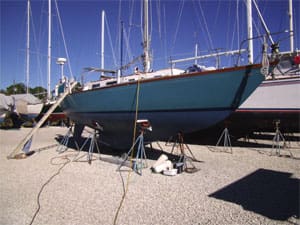To the editor: Those of us who winter on our boats and leave them propped up on jack stands, where they soak up the hot Florida sun during the summer, always hope that the diesel runs when we go back aboard in the fall. We always run the engine on our Tartan 34 Endeavour in the yard just to be sure. It’s not the same as a shakedown cruise, of course, but at least we can be reasonably satisfied that the diesel will run properly once we’re in the water. For the record, ours is a 17-year-old Westerbeke 30B Three with 3,800 hours. A great deal of the engine hours were from charging batteries, not propulsion. Now we use a Honda 2000 generator to charge the batteries, instead of the diesel.
 |
|
Alfred Wood illustration To provide a steady supply of cooling water for the diesel on his Tartan 34, Dick de Grasse put together the T fitting. |
Assuming the batteries are charged and there’s fuel in the tank, running the diesel in the yard when the boat is on jack stands or in a cradle means supplying cooling water to the engine. Most times a fresh water hose is available at the yard.
There are several considerations. The first is how do we get the water to the engine? In the past my wife Kathy was designated to hold the hose up against the cooling water input seacock under the boat. She, of course, got very wet. It was impossible to judge how much water was needed by the engine; should the hose be opened all the way or not? You can’t hold the hose in place for more than a few seconds when cranking, before the engine starts, without running the risk of filling the exhaust manifold with water and sooner or later filling one of the cylinders — a very bad situation. Also, running the engine water pump dry (without a source of cooling water) is not a good idea.
There is another way to solve the problem. A few years ago, I connected a short brass pipe to the half-inch engine seacock with a “T” at the end inside the boat. The T stem goes to the seawater filter and on to the engine water pump; the top end of the T has a brass plug in it. I made up a four-foot length of hose with a brass fitting on the end to screw into the T after the plug is removed. The hose needs to be long enough to reach a pail of water we set in the bilge.
With this setup in place we can cool the engine without the risk of too much or too little water, we simply shut the seacock off, remove the plug and install the four-foot length of hose. The open end of the hose is placed next to a 10-quart pail. We fill the pail with water from the yard hose and then, and only then, try to start the engine. The moment the engine starts we quickly place the hose into the pail of water. Several things happen: first the engine takes from the pail of fresh water only the amount of water it needs to cool properly; and second, there is no risk of filling a cylinder with water while cranking the engine since we don’t put the hose into the pail until the engine starts. An additional benefit is that Kathy doesn’t get soaked holding the hose up against the seawater through-hull.
The interesting question for me was how much cooling water is needed to cool a 30-hp diesel at idle? I was amazed. The 10-quart pail emptied in a very short time; about 15 to 20 seconds. The yard water hose was barely able to keep the pail full the entire time the engine was running. I usually run the engine until it reaches normal operating temperature.
There are two additional benefits to this rig: 1) the engine can serve as a high-capacity bilge pump in case of emergency and 2) I keep a two-foot length of #12 copper wire available for cleaning the seacock. If the engine overheats, the first thing I check for is something clogging the seacock; grass, barnacles, etc. While at sea, I can run the wire down through the T and out the engine seacock to clear obstructions. If the T is a little below the waterline, as it is with us, I hold a rag over the open T while using the wire.
Some owners put their boat in gear while running in the yard. I don’t do that for fear of unnecessarily adding wear to the drive shaft stuffing box and cutlass bearing; both are designed to be lubricated by seawater.
—Dick de Grasse and his wife Kathy live aboard their Tartan 34 Endeavour in the Caribbean during the winter and Maine in the summer.

